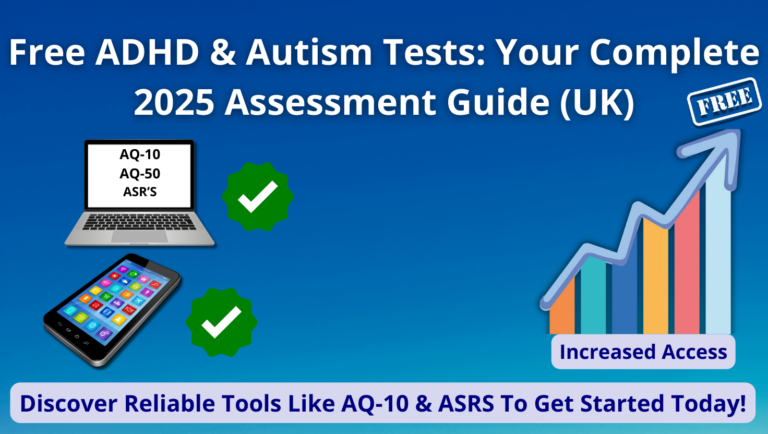CAMHS Referral Process: Complete Autism Assessment Guide (2025)

Key Takeaways:
The Child and Adolescent Mental Health Services (CAMHS) referral process typically starts with your GP, school, or social worker making a referral.
Current waiting times range from 4 weeks to 2+ years depending on your location and urgency of need.
While waiting, you can access various support services and consider alternatives like Right to Choose for specific assessments such as autism.
The process involves initial assessment, triage, and treatment planning, with urgent cases getting priority access.
Understanding how to properly prepare for referral and knowing your rights can significantly impact the success and speed of accessing CAMHS support.
Essential Resources:
- Right to Choose Guide for Faster Assessments – Alternative route for faster autism assessments
- NHS CAMHS Information – Official NHS guidance
- YoungMinds CAMHS Guide – Comprehensive support information
- Mental Health and Behaviour in Schools – School-based support guidance
- Every Mind Matters – Support while waiting for CAMHS
Did you know that an early autism assessment can significantly impact a child’s development?
For families seeking a CAMHS referral today, the journey has become increasingly challenging. According to recent NHS data, average waiting times have increased by 40% since 2019, making it more crucial than ever for parents to understand and navigate this process effectively.
Over 140,000 children in England are currently waiting for specialist autism assessments, with some areas reporting delays exceeding two years (Source: The Times).
While NHS CAMHS referrals are the traditional route, families in England may have the right to access faster assessments through the NHS Right to Choose legislation, which can help reduce waiting times while maintaining NHS funding. Learn more about reducing autism assessment waiting times through Right to Choose.
This guide will walk you through everything you need to know about CAMHS referrals, from initial concerns to post-assessment support, offering practical tips along the way!
What is CAMHS and How Can a CAMHS Referral Help With Autism Assessment?
CAMHS (Child and Adolescent Mental Health Services) is a specialised NHS service that provides mental health and developmental support for children and young people.
When it comes to CAMHS referrals, this service represents the primary pathway through the NHS for families seeking assessments.
Understanding how a CAMHS referral works can help make the assessment process clearer and less overwhelming.
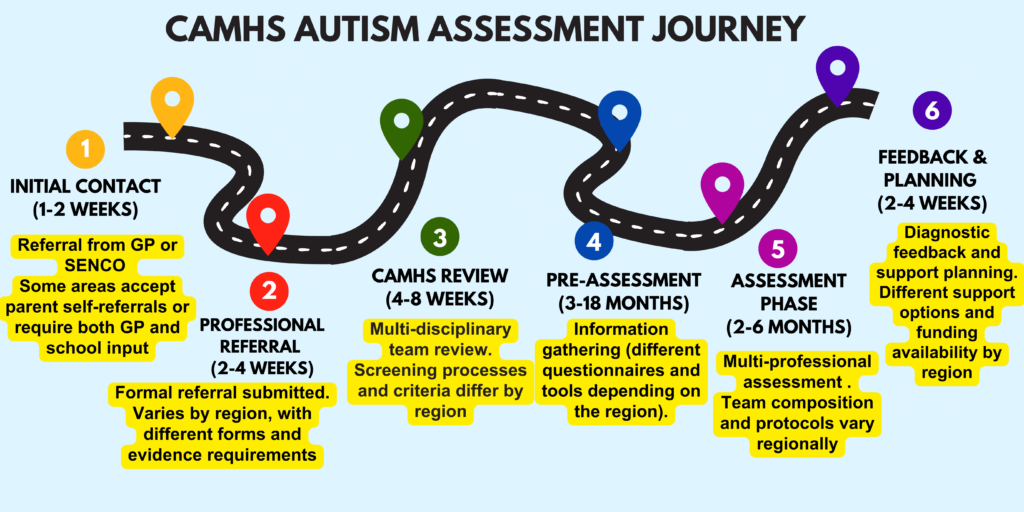
CAMHS collaborates with other healthcare and educational services to provide comprehensive support:
When pursuing a CAMHS referral, several key professionals and organisations work together to support your journey:
- GPs: Help with referrals and ongoing healthcare.
- Schools: Provide essential information about a child’s daily functioning and progress.
- Community Pediatric Services: Offer additional medical support.
- Local Autism Support Organizations: Provide practical help and community-based resources.
How Do I Start a CAMHS Referral and What Information Do I Need?
You can initiate the process through either:
Your GP:
- Book a longer appointment if possible.
- Prepare a list of your observations and supporting documentation.
- Be ready to describe specific behaviours with examples.
Your School SENCO:
- Request a meeting to discuss your concerns.
- Share school observations and any support already in place.
What Are the Best Practical Tips for Parents Navigating CAMHS Referrals?
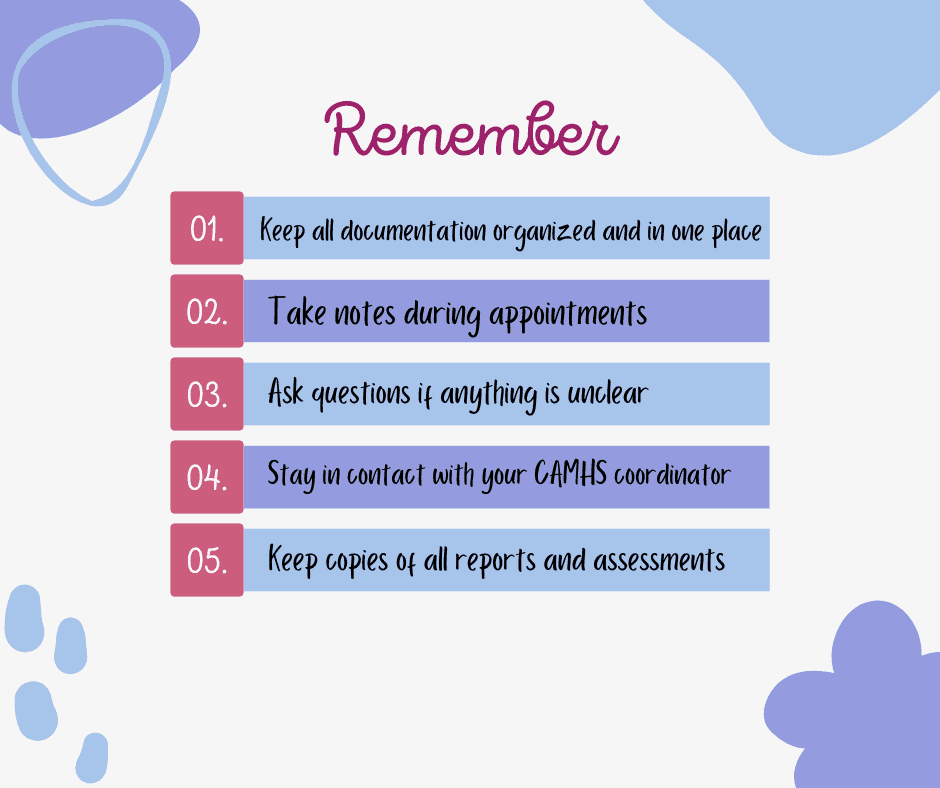
Understanding how CAMHS referrals work helps families navigate the assessment process more effectively.
While the system may seem complex at first, knowing the steps and what to expect can make your journey through CAMHS clearer and more manageable.
Is a CAMHS Referral Always Necessary for an Autism Assessment?
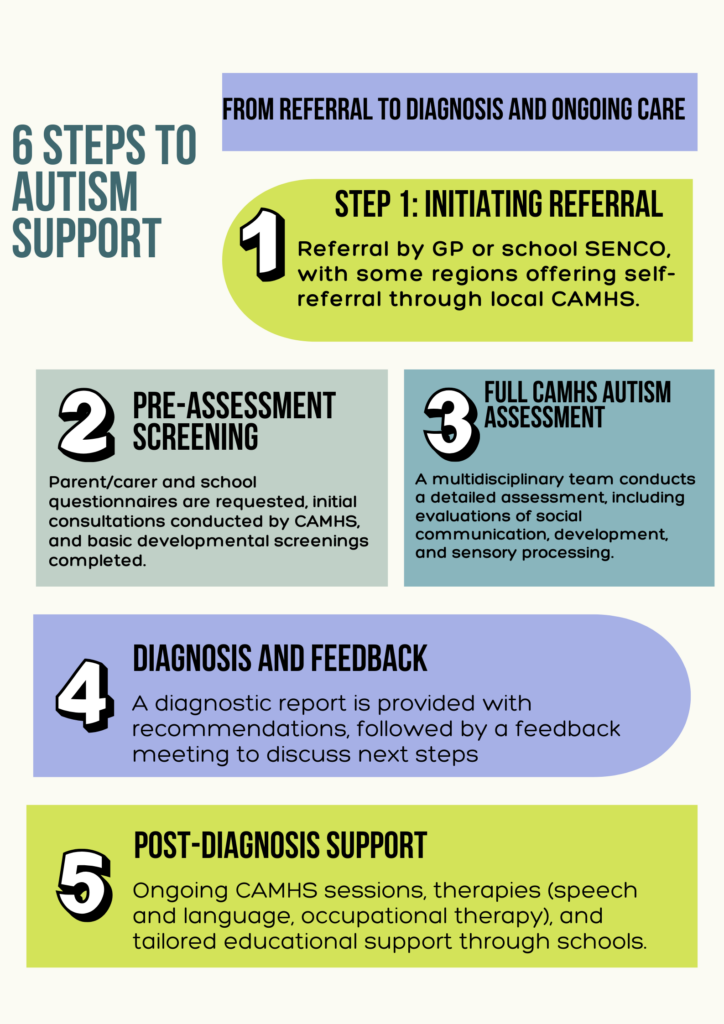
When Should You Consider a CAMHS Referral?
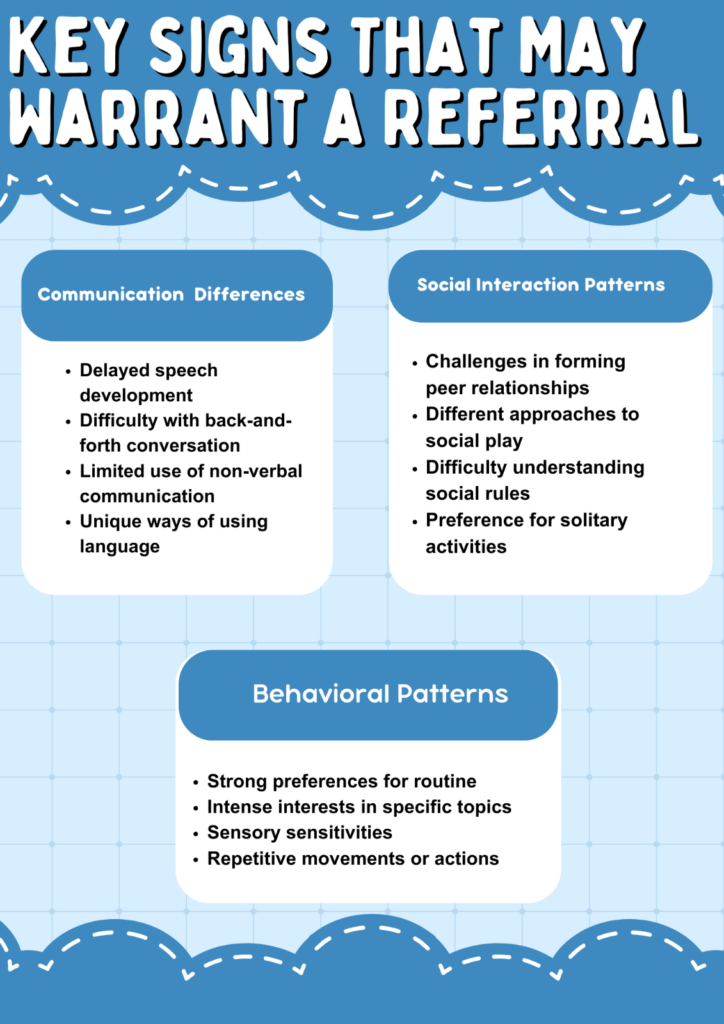
Where to Find CAMHS Referral Forms?
In most cases, CAMHS referrals are initiated by healthcare professionals such as GPs, teachers, or school SENCOs. However, in some regions, parents can self-refer directly to CAMHS by filling out a referral form.
To determine if self-referral is available in your area, contact your local CAMHS or visit the NHS directory:
- Find your local CAMHS service: NHS CAMHS Directory
Can a Parent Do a CAMHS Referral?
For CAMHS referrals, some areas allow parents to initiate the process themselves through a self-referral system. This typically involves completing a form with details about their child’s behaviour and developmental concerns.
Which Referral Path Should You Choose?
Understanding which referral pathway is most appropriate for your situation can help streamline the process.
While some families opt for GP referrals due to existing medical relationships, others may find the school SENCO route more suitable if their concerns primarily manifest in educational settings.
Regardless of the chosen pathway, it’s important to gather comprehensive documentation and seek guidance from reliable sources.
Where Can Parents Find Trusted Information About Autism Assessments?
For a comprehensive overview of the autism assessment process within the NHS, including what parents can expect during their child’s evaluation, visit the NHS guide on autism diagnosis.
Explore detailed insights into autism signs and characteristics, which can assist parents in recognising potential indicators that may warrant a referral, at the National Autistic Society’s page on signs of autism.
For detailed information on how CAMHS operates, including guidance on CAMHS Autism Referrals, the referral process, and what families can expect when seeking help, refer to the NICE quick guide on autism assessment and diagnosis.
For a comprehensive understanding of autism spectrum disorder, including its symptoms and diagnostic criteria, visit the National Autistic Society’s overview of autism.
What Are the Biggest Hurdles with CAMHS Referrals for Autism and How Can We Overcome Them?
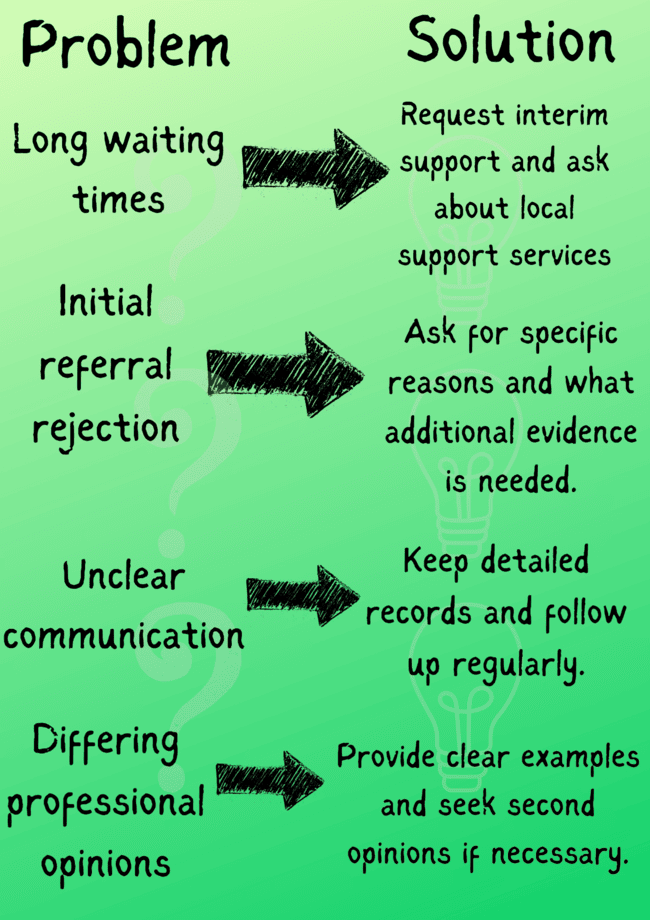
Autism Speaks Family Resources
How Can Parents Communicate Effectively During the CAMHS Referral Process?
When communicating with healthcare providers regarding a CAMHS referral:
1. Keep organised records:
- Date all communications
- Document phone conversations
2. Be specific and clear:
- Use concrete examples
- Describe behaviors objectively
- Explain the impact on daily life
- Focus on key concerns
3. Follow up effectively:
- Confirm next steps in writing
- Ask for timeframes
- Request clear action points
- Keep track of who you’ve spoken with
4. Ask questions:
- Write questions down beforehand
- Request clarification if needed
- Ask about alternative options
- Seek explanations for decisions
I’ve Made a CAMHS Referral – What Happens Next?
- Following up on the referral status
- Preparing for initial screenings or assessments
- Gathering additional documentation as requested
- Understanding the typical timeline for next steps
- Accessing interim support services while waiting

How Should Parents Prepare for a CAMHS Assessment?
- Explain the process: Use simple, positive language to describe the purpose of the CAMHS referral and assessment. Reassure your child that it’s a way to understand them better and provide the support they need.
- Encourage communication: If your child can express themselves, invite them to share concerns or questions and address these calmly.
- Create comfort: For non-verbal children, focus on establishing predictability and a sense of security.
- Use visual aids: Picture schedules or storyboards can help explain what will happen during the assessment, easing any anxiety.
- Practice routines: Familiarise your child with activities like waiting in a room or meeting new people to build confidence.
- Bring comfort items: A favourite toy or blanket can provide reassurance and help your child feel more at ease during the appointment.
Preparing in these ways can make the CAMHS referral assessment process smoother for both you and your child.
What Documentation Do You Need for a CAMHS Assessment?
CAMHS typically requires parent/carer and school questionnaires to be completed before the assessment:
1. Parent/Carer Questionnaires:
- Detailed behavioural questionnaires
- Development and medical history forms
- Daily routine and lifestyle information
- Family history documentation
- Sensory profile questionnaires
2. School Questionnaires:
- Teacher observation forms
- Educational progress reports
- Behavioural monitoring records
- Social interaction assessments
- Gathering School Reports and Observations
Why Is School Documentation Important in the CAMHS Autism Assessment Process?
Understanding the process and timeline of a CAMHS referral can help reduce anxiety and set realistic expectations for both you and your child.
This information helps the assessment team develop a clearer understanding of the child’s strengths and challenges.
These observations complement parental input and give the assessment team a more comprehensive understanding of the child’s needs.
Required School Reports:
- Academic progress reports
- Special educational needs assessments
- Behavioural incident logs
- Social interaction observations
- Learning support programs
Additional Educational Evidence:
- Examples of schoolwork
- Records of any support interventions
- Playground observation notes
- Communication with school staff
- SENCO assessments and reports
- Documentation of Developmental History
What Does Creating a Comprehensive Developmental History Include?
Early Development Records:
- Birth and medical history
- Developmental milestones
- Early childhood behaviours
- Speech and language development
- Motor skills progression
Previous Assessments:
- Health visitor records
- Early years reports
- Previous therapy assessments
- Medical specialist reports
- Private assessment documentation
- Initial Screening Processes
What Happens During the Initial Screening Process?
CAMHS Referrals may include initial screenings to gather preliminary information before the full assessment.
1. Preliminary Assessments:
- Initial consultation meetings
- Brief behavioural observations
- Basic developmental screening
- Social Communication Assessment
- Sensory processing evaluations
2. Screening Tools:
- Standardised autism screening questionnaires
- Development assessment scales
- Communication screening tools
- Behaviour assessment tools
How Can You Prepare Your Child for the Assessment?
Help your child feel comfortable by explaining the process, addressing concerns, and using familiar items to provide reassurance before the CAMHS Referral assessment.
Practical Preparation:
- Explain the process in age-appropriate terms
- Visit the assessment location if possible
- Maintain regular routines
- Choose suitable appointment times
- Pack familiar items for comfort
Supporting Documentation:
- Keep a diary of your child’s typical behaviours
- Record any specific concerns
- Note successful coping strategies
- Document preferred activities
- Track sleep and eating patterns
How Can You Organise Your Information?
Create an organised system for managing all documentation:
Physical Documentation:
Use a dedicated folder or file
Separate sections for different types of information
Keep copies of all submitted documents
Maintain a chronological order
Include a contact list of professionals
Include a contact list of professionals
Digital Records:
- Save electronic copies of all documents
- Create backup copies
- Organise emails in folders
- Keep a digital timeline
- Store assessment dates and notes
The pre-assessment process may feel extensive, but thorough preparation ensures the CAMHS Referral team has all the necessary information to understand your child’s needs.
Keep documentation organised and accessible for easy reference throughout the process.
How Long Will I Wait for a CAMHS Referral and What Can Affect the Waiting Time?
Waiting times for CAMHS referrals can vary significantly across different regions in the UK. Understanding these variations and knowing how to access support during the waiting period can help families manage this challenging time more effectively.
Current Average Waiting Times
Waiting times for a CAMHS referral can vary significantly between different NHS trusts:
- Metropolitan areas: 6-18 months average wait
- Rural areas: 12-24 months average wait
- Some regions may have shorter or longer waiting times
- Emergency cases may be prioritised
- Private assessments may have shorter waiting times
Note: These times can change frequently based on local resources and demand. It’s important to contact your local CAMHS service for current waiting times regarding your CAMHS referral.
For families concerned about these waiting times, there may be alternative options available through NHS funding. Learn more about reducing your wait time through our comprehensive guide: [How to Use the Right to Choose Scheme for Autism Assessments in the UK]
What Factors Can Affect CAMHS Waiting Times?
Several factors can influence how long you might wait for an assessment:
Local Resources:
- Number of specialists available
- Funding allocation
- Assessment team capacity
- Local demand for services
Case Complexity:
- Additional medical needs
- Age of the child
- Urgency of the situation
- Completeness of referral information
Regional Variations:
- Different assessment pathways
- Local service structure
- Population density
- Available facilities
What Interim Support Is Available While Waiting for a CAMHS Referral?
While waiting for assessment, several support options are available:
Educational Support:
- School-based interventions
- SENCO assistance
- Learning support programs
- Classroom adaptations
Healthcare Support:
- GP monitoring
- Health visitor guidance
- Local children’s centers
- Early help services
How Can You Manage Expectations?
Understanding the process and timeline of a CAMHS Referral can help reduce anxiety and set realistic expectations for you and your child and help reduce anxiety.
Communication with Services:
- Regular updates on waiting list position
- Clear point of contact
- Understanding of assessment process
- Transparent timeframes
Understanding the Process:
- Typical assessment timeline
- Required documentation
- Assessment stages
- Expected outcomes
How Can Parents Effectively Use the Waiting Period for CAMHS Referral?
Productive ways to use the waiting time for a CAMHS Referral include gathering relevant documentation, accessing interim support services, connecting with local autism resources and learning more about autism in preparation for the upcoming assessment.
Documentation:
- Keep detailed behaviour diaries
- Record developmental progress
- Document concerns and questions
- Collect relevant reports
Support Implementation:
- Try recommended strategies at home
- Work with school on support plans
- Develop consistent routines
- Build support networks
Preparation Activities:
- Research autism resources
- Connect with support groups
- Attend parent workshops
- Gather information about services
Self-Care Strategies:
- Access parent support
- Maintain family routines
- Develop support networks
- Focus on overall wellbeing
Remember that while waiting times for a CAMHS Referral can be challenging, using this period constructively can help develop understanding and support strategies that will be valuable regardless of the assessment outcome.
Regular contact with your referrer or CAMHS service is important to ensure your case remains active and to update them with any significant changes in circumstances that might affect the assessment priority.
What Does the CAMHS Autism Assessment Process Include?
Understanding what happens during a CAMHS referral assessment can make the process less daunting for both parents and children. The assessment is thorough and usually occurs over several appointments to ensure a complete understanding of your child’s development.
What Types of Autism Assessments Does CAMHS Provide?
CAMHS conducts several different types of assessments to build a complete picture:
Social Communication Assessment:
Developmental Assessment:
Sensory and Movement Assessment:
Who Are the Professionals Involved in a CAMHS Autism Assessment?
Each professional brings specific expertise to the assessment:
What Does a Clinical Psychologist Do During CAMHS Assessment?
How Does a Speech and Language Therapist Assess Autism?
What Role Does an Occupational Therapist Play in Autism Assessment?
What Should You Expect During Autism Assessments?
A typical assessment journey includes:
What Happens at Your First CAMHS Assessment Appointment?
What Do CAMHS Assessment Sessions Involve?
What Tools Are Used During CAMHS Autism Assessments?
Professionals use standardised assessment tools including:
How is the ADOS Assessment Used in Autism Diagnosis?
What is the ADI-R Assessment and How is it Used?
Additional Tools:
How Do Parents and Teachers Contribute to CAMHS Autism Assessments?
Parents and teachers play crucial roles:
How Can Parents Contribute to the CAMHS Assessment?
- Contributing to assessments
- Providing detailed history
- Completing questionnaires
- Attending appointments
- Sharing observations
What Information Do Teachers Provide for CAMHS Assessment?
- School observations
- Academic progress reports
- Behaviour descriptions
- Social interaction notes
- Learning style information
The CAMHS referral assessment process aims to build a thorough understanding of your child’s strengths and challenges. Each component contributes to creating a complete picture that guides appropriate support and intervention strategies.
During CAMHS assessments, professionals ask a range of questions to gain a comprehensive understanding of your child’s behaviour, development, and communication. Below are typical topics and questions asked during these evaluations.
Developmental History:
- At what age did your child meet key milestones, such as walking or talking?
- Were there any complications during pregnancy or birth?
- How has your child’s behaviour evolved over time?
Social Interaction:
- How does your child interact with peers and family members?
- Do they engage in eye contact or show interest in group activities?
- How do they respond to unfamiliar people or new social situations?
Communication:
- Does your child express themselves using words, gestures, or other methods?
- How well do they understand spoken instructions or abstract concepts?
- Are there repetitive speech patterns, phrases, or echolalia (repeating words)?
Sensory Responses:
- Are there any sensitivities to sensory input (e.g., loud noises, bright lights)?
- Do they display unusual reactions to textures, smells, or foods?
- How do they handle changes in routine or surroundings?
Play and Interests:
- What activities or toys does your child enjoy?
- Are there any highly focused interests or repetitive play behaviours?
- Do they engage in imaginative or pretend play?
How Can Parents Support Their Child During CAMHS Assessment?
While waiting for and going through the CAMHS referral assessment process, there are many ways to support your child and create a positive environment. This guide provides practical strategies and approaches to help both you and your child navigate this period.
Creating a Supportive Home Environment:

How Can Parents Create Supportive Routines During Assessment?
- Create clear daily schedules
- Use visual timetables if helpful
- Maintain consistent mealtimes
- Follow regular bedtime routines
- Plan transitions carefully
How Do You Create Sensory-Friendly Spaces at Home?
- Create quiet areas for relaxation
- Manage lighting and noise levels
- Provide comfort items
- Consider sensory preferences
- Organise belongings clearly
For further guidance on creating a supportive home environment; https://www.autism.org.uk/advice-and-guidance/topics/physical-environment/environment
Working with Schools During Assessment
How Should Parents Communicate with Schools During Assessment?
- Regular updates with teachers
- Share assessment information
- Discuss support strategies
- Monitor progress together
- Keep communication channels open
What Kind of Support Can Schools Offer During the CAMHS Referral and Assessment Process?
- Classroom adaptations
- Discuss learning support
- Explore break time support
- Consider quiet spaces
- Implement visual aids
For additional guidance on working with schools during assessment; https://www.autism.org.uk/advice-and-guidance/topics/education/working-with-your-childs-school
Managing Anxiety and Uncertainty
How can you prepare your child emotionally for the assessment?
- Celebrate strengths
- Validate feelings
- Maintain open dialogue
- Offer reassurance
- Listen without judgment
Practical Coping Strategies
Implement strategies to help daily functioning:
What communication tools can enhance your child’s ability to express themselves?
- Visual schedules
- Emotion cards
- Choice boards
- Timer use
- Communication aids
Anxiety Management:
How can parents use various techniques to help children cope with anxiety?
- Breathing exercises
- Quiet time activities
- Movement breaks
- Comfort objects
- Safe spaces
If My CAMHS Referral is Rejected, What Are My Options?
It can be incredibly disheartening to have a CAMHS referral rejected. You might feel lost, confused and unsure where to turn next. Know that you are not alone and a rejection doesn’t mean your child doesn’t need support. It simply means we need to explore alternative pathways.
Why Referrals Get Rejected (and It’s Not Always a Reflection of Your Child’s Needs)
CAMHS resources are stretched, and they have specific criteria for accepting referrals. Some common reasons for rejection include:
- Insufficient Information: The referral didn’t provide enough detail about your child’s difficulties.
- Not Meeting Threshold: Your child’s needs, while valid, may not meet the severity threshold for CAMHS intervention.
- Alternative Services More Appropriate: Other services might be better suited to address your child’s specific needs.
- Incorrect Referral Pathway: The referral wasn’t submitted through the correct process.
What Are Your Options? Concrete Steps to Take
Don’t give up! Here are several steps you can take:
- Appeal the Decision
You have the right to appeal a rejected referral. Contact CAMHS directly (find their contact information on your local CAMHS website) and ask about their appeals process. Gather any additional evidence that supports your case, such as letters from teachers, updated assessment reports, or a detailed log of your child’s challenges.
- Seek a Second Opinion
Consult with another healthcare professional, such as a different GP or a pediatrician. A fresh perspective can be valuable, and they may be able to provide a new referral or suggest alternative approaches.
- Consider a Private Assessment (if appropriate)
If you suspect your child has autism or another specific condition, a private assessment can provide valuable insights and a formal diagnosis. Be aware that private assessments can be costly.
Research qualified and registered practitioners in your area. Always verify their credentials and ensure they are registered with the appropriate regulatory bodies.
- Explore Alternative Therapies and Support
Many therapies and support services can benefit children, even without a CAMHS referral. These include:
- Play therapy
- Art therapy
- Cognitive Behavioral Therapy (CBT) – Learn more about CBT on the NHS website (https://www.nhs.uk/mental-health/talking-therapies-medicine-treatments/talking-therapies-and-counselling/cognitive-behavioural-therapy-cbt/overview/).
- Social skills groups – Find social skills groups through local charities or organizations like The National Autistic Society (https://www.autism.org.uk/).
- Parenting support programs – Organizations like Family Lives (https://www.familylives.org.uk/) offer parenting support and advice.
Contact local charities and support organizations for information on available services. Also, talk to your child’s school about the support they can provide.
Key Resources and Further Information
- Your Local CAMHS Website: (Find the website for your local CAMHS service by searching “[your town/county] CAMHS”)
- NHS Mental Health: Comprehensive information on mental health conditions and treatments (https://www.nhs.uk/mental-health/).
- Mind: A leading mental health charity providing support and information (https://www.mind.org.uk/).
- The National Autistic Society: (If autism-related) The UK’s leading charity for autistic people and their families (https://www.autism.org.uk/).
- Family Lives: Offering support and advice on all aspects of family life, including special educational needs (https://www.familylives.org.uk/).
- Scope: Providing practical information and support for disabled people and their families (https://www.scope.org.uk/).
Remember, you are your child’s best advocate. Keep exploring options and seeking the support they need. A rejected referral is a setback, but it doesn’t have to be a dead end.
[Disclaimer: The Special Needs Resources Directory is not responsible for the content of external websites.]
How Can Parents Build a Support Network for Autism Assessments?

Navigating the autism journey can feel overwhelming, but you don’t have to do it alone. Building a strong support network is essential for both parents and children.
This involves connecting with professionals for expert guidance and accessing community-based support to share experiences and gain practical advice during the CAMHS autism referral process.
Below are key ways to establish both professional and community support, ensuring you have the right resources at every stage of your child’s development.
Professional Support:
Have you considered exploring counseling services for additional support during the CAMHS referral process?
- Stay in contact with CAMHS to ensure you’re up-to-date with your child’s progress and any next steps.
- Connect with educational staff to create a cohesive support system for your child at school.
- Access support services that offer specialised assistance tailored to your child’s needs.
- Seek GP guidance for a comprehensive view of your child’s health and potential treatment options.
Community Support:
How can community support help you during the CAMHS referral process?
Building a strong support network within the community is equally vital in navigating the CAMHS autism referral process.
Here are some ways to find additional help and share your experience:
- Share experiences with others to feel empowered and supported.
- Join parent groups to connect with those who understand your challenges.
- Connect with autism charities for resources, advocacy, and emotional support.
- Access online forums to get advice from a wider community of parents and professionals.
- Attend workshops to learn practical strategies for managing your child’s needs.
What Are the Best Strategies for Maintaining Family Wellbeing During CAMHS Assessments?
Parent Support:
- Take breaks to avoid burnout and recharge.
- Seek emotional support from friends, family, or therapy.
- Share responsibilities with others to lighten the load.
- Access parent training to better understand the process.
- Practice self-care to manage stress and stay healthy.
Sibling Support:
- Explain the process in simple terms to reduce confusion.
- Allow one-on-one time with siblings to make them feel special.
- Address any concerns siblings may have openly.
- Maintain routines to offer stability during uncertain times.
- Include siblings in activities to keep them engaged.
Overall Family Considerations:
Every family is unique, so adjust these strategies to fit your needs during the CAMHS autism referral process. Be patient with yourself and your child, focusing on celebrating strengths while providing support for challenges.
What Support is Available After a CAMHS Autism Assessment?
The assessment team will provide feedback that includes:
Diagnostic Report:
- Findings and conclusions
- Identified strengths and challenges
- Recommendations for support
- Future development considerations
Feedback Meeting:
- Review of assessment results
- Opportunity to ask questions
- Explanation of next steps
- Discussion of support options and future interventions
By reviewing the diagnostic report and engaging in the feedback meeting, parents can better understand their child’s needs and begin planning appropriate support.
How Do You Access NHS Support After an Autism Diagnosis?
Accessing support post-diagnosis is essential to ensure tailored care for children and young people with autism.
In the UK, two main pathways are typically available:
CAMHS Support:
Child and Adolescent Mental Health Services (CAMHS) offer various interventions, including:
- Follow-up appointments to track progress and adjust care plans.
- Parent training programs to help parents support their child’s development.
- Specialist interventions to address specific ASD-related challenges.
- Ongoing monitoring to meet evolving needs.
- Transition planning to support the shift from child to adult services.
By utilising CAMHS, families can ensure their child receives continuous, specialised care.
How Can I Access Local CAMHS Services?
To find your local CAMHS referral service and begin the process, use the NHS service finder tool. Find Mental Health Services (NHS).
This tool can help you locate nearby CAMHS providers and access information about referral processes, waiting times, and available support in your area.
For more detailed information on accessing CAMHS services, visit the NHS page on Autism Support. This page offers comprehensive resources about autism spectrum disorder (ASD) and the support available through CAMHS.
Additionally, organisations like Young Minds provide valuable guidance and support networks for families and individuals affected by autism.
NHS Services:
What additional support services does the National Health Service (NHS) offer for children and young people with ASD?
- Speech and Language Therapy: Assistance with communication skills.
- Occupational Therapy: Support for developing daily living skills.
- Clinical Psychology Support: Therapeutic interventions for mental health challenges.
- Mental Health Services: Comprehensive care for co-occurring mental health conditions.
- Additional Health Assessments: Evaluations to identify and address other health concerns.
Access to these services typically requires a referral from a healthcare professional, such as a GP or specialist.
It’s important to note that waiting times for assessments and treatments can vary, and in some areas, delays have been reported.
For more information on the NHS services available for autism, visit NHS Autism Support.
What Educational Support Options Are Available for Children With Autism?
Schools can provide various support mechanisms:
School-Based Support:
- EHCP (Education, Health and Care Plan) assessment
- SEN support plans
- Classroom adaptations
- Learning support assistance
- Social skills groups
Educational Resources:
- Specialist teaching strategies
- Visual supports and aids
- Sensory equipment
- Communication tools
- Learning adaptations
What Healthcare Pathways Are Available After a CAMHS Autism Assessment?
Ongoing healthcare support includes:
Medical Support:
- Regular health reviews
- Medication monitoring if prescribed
- Specialist referrals if needed
- Health coordination
- Annual health checks
Therapy Services:
- Individual therapy sessions
- Group interventions
- Parent-child programs
- Skills development
- Behavioural support
What Family Support Services Are Available for Parents and Carers?
Local Authority Support:
- Short breaks services
- Family support workers
- Respite care options
- Social care assessment
- Benefits advice
Community Support:
- Parent support groups
- Sibling support programs
- Family activities
- Local autism groups
- Social opportunities
What Should Parents Do After a CAMHS Referral Is Made?
Key steps for ongoing support:
Action Plan:
- Set goals and priorities
- Plan and adjust interventions
- Review progress regularly
Record Keeping:
- Maintain documentation and track progress
- Keep service contacts and document meetings
- Store reports safely
Support needs may change, so regular reviews are essential. Reach out to professionals if you need guidance or if circumstances change.
Useful Contacts
Keep a list of key contacts:
Professional Contacts:
- CAMHS team
- GP details
- School SENCO
- Therapists
- Support workers
Support Organisations:
- Local autism services
- National autism charities
- Parent support networks
- Advocacy services
- Emergency contacts
This post-assessment period is about understanding and implementing the right support for your child and family.
Take time to process the information and remember that support services are there to help you navigate this journey.
What Are the Most Common Questions About CAMHS Autism Assessments?
Conclusion:
Navigating the CAMHS autism referral process doesn’t have to be overwhelming. By understanding each step and being prepared, you can better advocate for your child’s needs.
Remember, seeking support is the first step toward understanding and supporting your child’s unique journey. Don’t hesitate to reach out to support groups and professionals along the way!
About the Authors: Dwayne and Charlene are committed to providing accessible and reliable information to families with special needs. Charlene’s extensive experience working with children of all abilities as a professional childminder combines with Dwayne’s personal journey as a father to their son with autism to provide families with a deep understanding of the issues families face. Together, they offer practical guidance and support.



